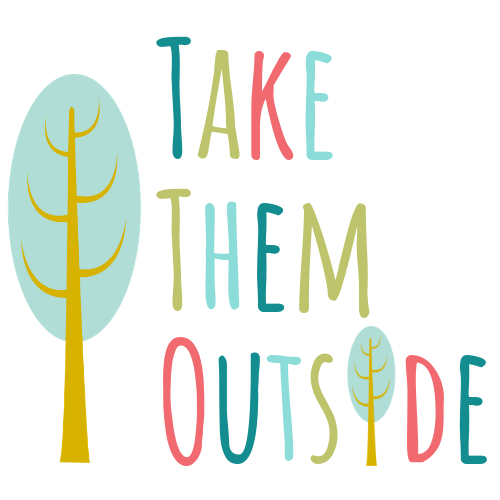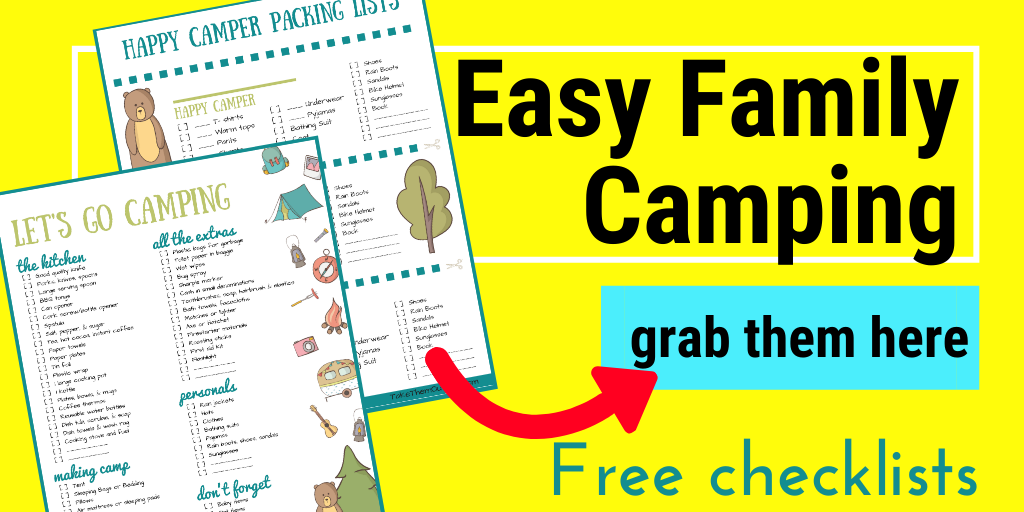Camping always presents new challenges for tasks that are usually simple to execute at home. Take boiling water, for example. But, depending on your particular camping situation, below you’ll learn the best way for you and tips on boiling water faster and safer!
Looking for the quick answer: How to Boil Water When Camping?
1. If you have access to a power source, just bring along an electric kettle!
2. Use a portable stove and small pot for heating water. A small propane stove or gas stove are the most common.
3. Put a pot of water over an open fire: a campfire, wood-burning stove, or charcoal grill.
4. For gear lovers and outdoor enthusiasts, you might want to try using a solar-powered kettle.
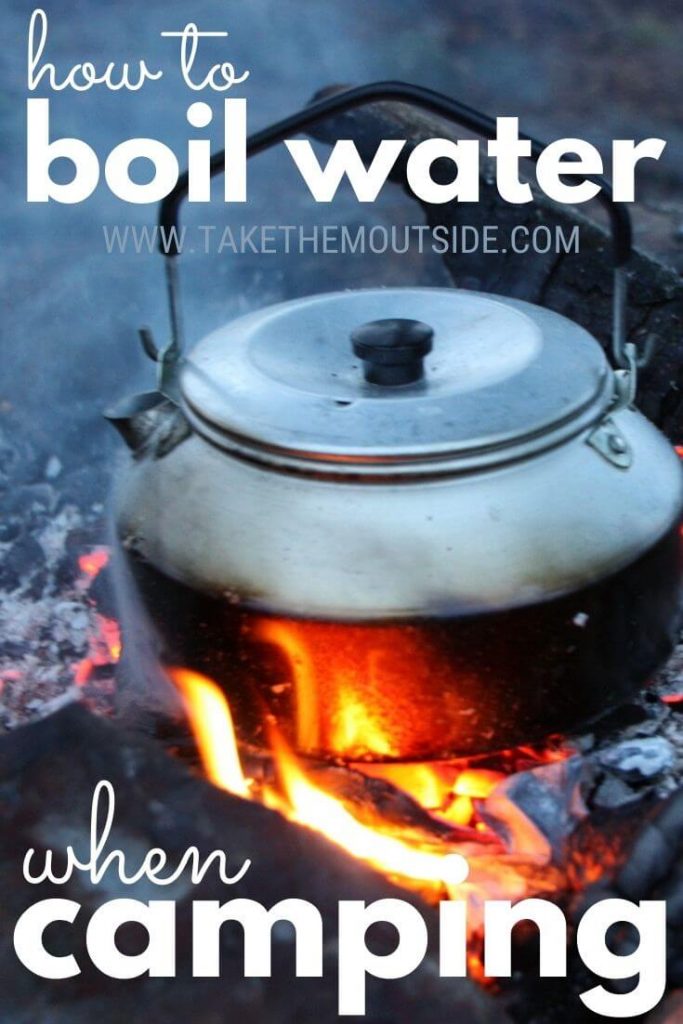
(This post contains affiliate links for your convenience. As an Amazon Associate I earn from qualifying purchases. If you make a purchase through my link I receive a small commission at no added cost to you. See my policy page for more information)
A Special note: How long does it take to boil water when camping?
The time it takes to boil water could vary from a few minutes to half an hour, depending on various factors such as fuel source, volume of water, air and water temperatures, and altitude.
Some reviews will tell you how long each stove or method will take to boil water. I have chosen to not include this time because it really can vary.
But, I will tell you this, portable gas stoves are faster than campfires. The Jetboil system alleging that they can boil water the fastest of all camp stoves… in only 100 seconds!
When my hubby and I camp, we usually have boiled water in about 5-10 minutes.
How to boil water faster when camping:
1. Use only as much water as you need. More water takes longer to boil.
2. Start with warm water. If you water source is cold water (like glacier feed streams, as mine usually are), fill your pot before you’ll need to boil it and let it warm up to air temperature before heating it.
3. Set up your stove out of the wind. Use boulders, packs, trees (or a wind shield if your stove has one).
4. A pot with a lid will boil faster as the heat is trapped inside the pot
The easiest option: The electrical kettle
If you’ll have access to electrical outlets on your camping trip then just bring along your electric kettle! Easy!
By far, this is the easiest way to get as much hot water as you’ll need! And, it’s quick too!
The next easiest option: Boiling water with a portable camp stove
Your setup can be as simple as a light weight backpacking stove or the Classic Coleman Propane Stove . No matter which type of stove you use, water will be boiled!
Below is a picture of our general set-up for boiling water when out hiking and canoeing: We have a Snow Peak GigaPower Stove. We use it on all our backcountry trips. It’s super light and works great!
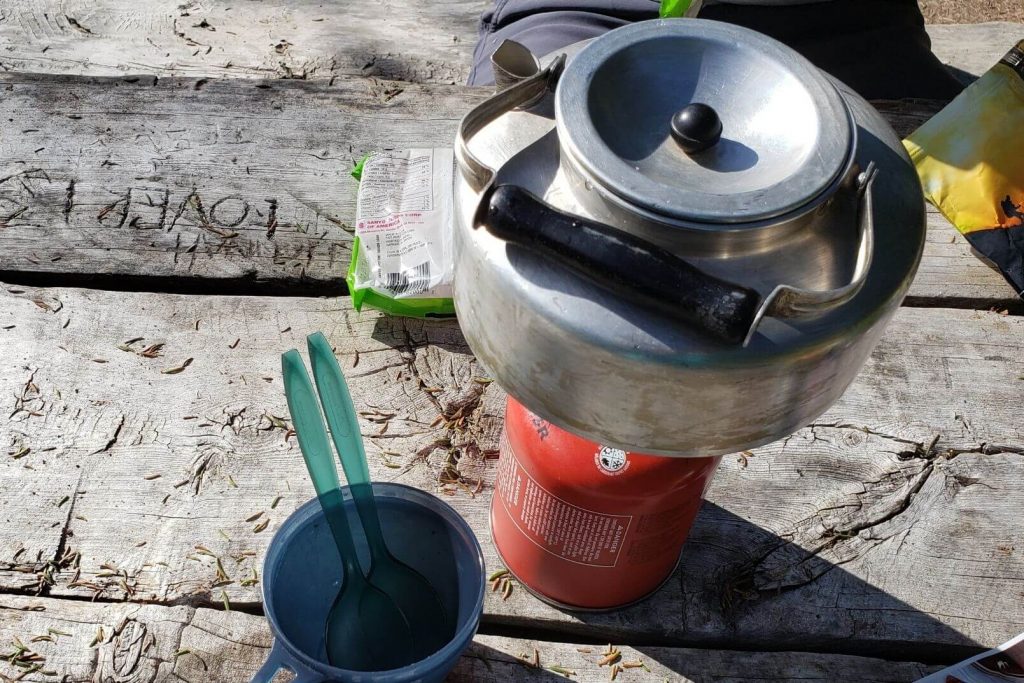
This is the Snow Peak Camping Stove we have and use and love:
Be aware, though, sometimes a single burner without a wind guard will have trouble keeping the fire lit and you may use more fuel heating your water. It is worth the little bit of extra money to purchase a wind guard and avoid this headache or develop systems of setting up a wind break while cooking.
Safety Tip: Please read the specifications to your particular stove to make sure a wind guard is safe with your model.
Practical Tip: Consider the location of your stove… place your stove low to the ground and use large rocks, packs, and people as wind blocks when trying to heat water in the windy great outdoors.
Important: If you’re depending on this method to sanitize your water and cook all your food while you’re camping, do make sure you have enough fuel for the entire duration of your trip (especially if you’re remote camping). Bringing along an extra gas or propane canister is often a good idea!
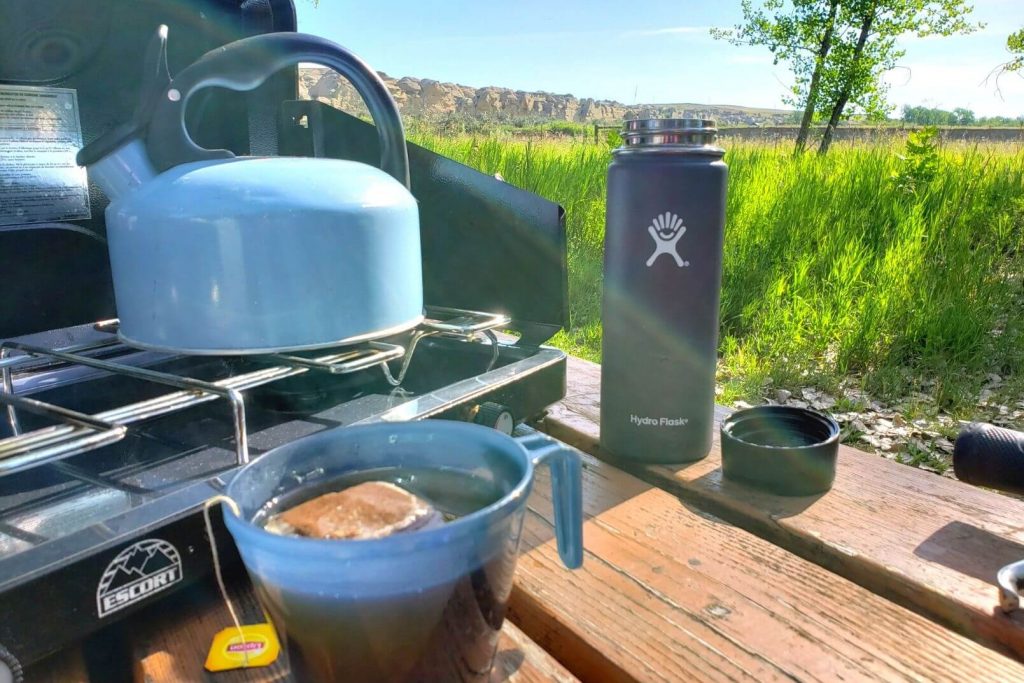
Depending on what you need your boiled water for, you can use a regular old pot to boil your water, a traditional kettle, or I’ve even seen campers put their enamel cup with water right onto their stove and avoid the specific heating vessel all together!
Good Idea: You may want to get a camping pot that can handle being used over both a camp stoves and a campfire, just in case you don’t have a choice sometime.
READ MORE: Check out this post on camping cooking sets for more details on types of pots and cooking equipment and this post is a great guide to all the different camping kettle options.
Jetboil Stoves: The Portable Cooking System
If you’re looking to spend a little money on an option that is smaller and more portable, Jetboil camping cooking systems are pretty fancy creations. Small but mighty, this method won’t heat a ton at a time, but it is perfect for a person or two on a backpacking trip.
On the trail, some campers just love their Jetboils! We don’t have one of these because we prefer the versatility of our camping cooking gear.
- Optimized for efficiency, the Jetboil Flash camping and backpacking stove, in Wild, boils water in a lightning-quick 100 seconds, making it the fastest Jetboil ever.
- Jetboil's 1-liter FluxRing cooking cup with insulating cozy makes boiling water—and keeping it warm—a breeze, making the Jetboil Flash personal cooking system the ultimate camping stove for preparing coffee, soup, or dehydrated meals on the trail.
- Start heating instantly with the convenient, reliable pushbutton igniter, and verify that the water's ready with the thermochromatic color-change heat indicator.
- Bottom cup doubles as a measuring cup and a bowl.
- Compatible Jetboil accessories, such as a coffee press*, hanging kit*, pot support*, skillet*, FluxRing cooking pot*, and utensils* make this a necessity for your next backpacking adventure. *Accessories sold separately.
What about alcohol stoves for boiling water?
Alcohol stoves are generally less efficient than a gas powered camping stoves and may take upwards of twice as long to boil your water.
We haven’t used alcohol stoves to boil water while camping, so I can’t tell you about our personal experiences here. But, this post was very thourough and should answer all your alcohol stove questions.
Boiling water over the campfire
The next choice seems obvious at a campsite: build yourself a campfire!
The mainstay of camping, some people prefer the challenge of using a campfire for all their food and boiled water needs. It can be fairly simple, depending on your setup.
How to boil water over an open fire:
1. You’ll need a safe fire pit (use the fire pit provided or dig out a pit and encircle it with rocks).
2. Set up a grill or tripod to suspend your cooking pot or kettle over the flames.
3. Use a fire-safe pot or kettle (no plastic handles!). Fill it with water, set it above the fire, and wait.
For those of you who only camp at campgrounds, you’ll likely have a safe fire pit provided for you. Many of these fire pits also have grates to put over them to put your kettle or pot on, so you won’t have to worry about how to keep your kettle out of the flames.
This is our general set-up for boiling water over campfires at campgrounds:
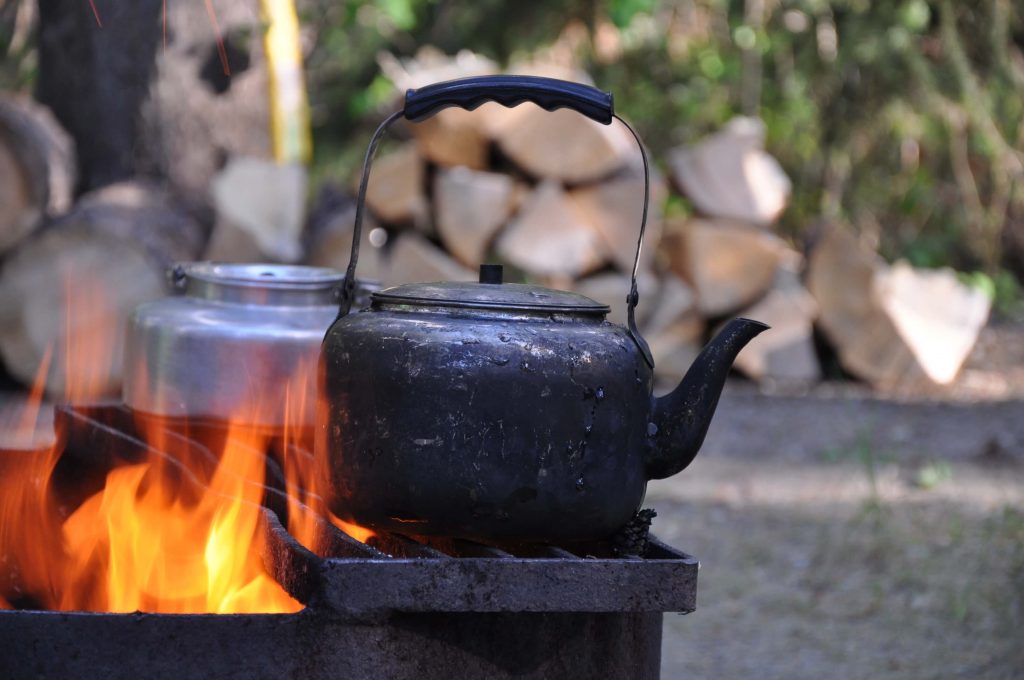
If you are camping in the wilderness, you will have to set up your own fire ring and use proper safety protocols to ensure you don’t accidentally start a wildfire. Consider things like wind- not only which way the wind is blowing, but how hard it’s blowing. You’ll also want to check the fire safety levels in that area… how dry the weather has been and whether or not you are allowed open fires.
For your wilder campfires, be sure to have a grate or a tripod so you can set your kettle or pot on top and keep them over the flames instead of in the flames.
Or, you can place your kettle down into the embers, but depending on how hot your fire is/was, it could take some time to get a rolling boil. You might also find some ash has landed in your kettle as well. If you are going to boil your water this way, using a pot with a lid will keep the ash out of the water, but it could be harder to tell when the water reaches a boil.
Practical Tips: Don’t forget a potholder or something to take the hot pot off the fire as well as a well-stocked first aid kit, just in case you burn yourself! Using a stick can work well if you have a good handle on your kettle/pot.
Solar Water Heating Bags
Perhaps a more unconventional method is using solar water heating bags. Looking around the internet it seems like some people use these for heating up a lot of water, such as for a warm shower or hot water for dishwashing.
Keep in mind, solar bags will be a little more dependent on your weather conditions, so you may need to be prepared with backup options in case of a cloudy day. They also take time to heat up, so you’ll need to plan well ahead for this method to work.
I’m also assuming you can’t boil water in these and so if you’re using boiling as a water purification method, you probably want a backup!
Safety tip: you’ll also want to make sure your particular bag is food-safe.
Solar Kettle
For smaller amounts of water, a solar kettle could be a great option. You can heat water to boiling in 20-40 minutes, depending on your conditions (according to the product specifications), and you won’t have to start a fire or get out a bulky stove. This is also a much better portable option, as solar kettles are fairly compact.
Reading through the reviews, it seems these work best in hot/warm climates. I don’t think I’d want to rely on one of these in Canada. Nor do I think I’d want to rely on this as my only way to boil water… but as a backup for for those that like gadgets, this might be fun!
Is that water safe to drink?
When camping at a campground, it’s easy to grab some water from the spigot and not worry about whether it’s clean water, safe to drink or not. But when you’re on a backpacking trip or remote camping, you’ll need to be aware of water safety.
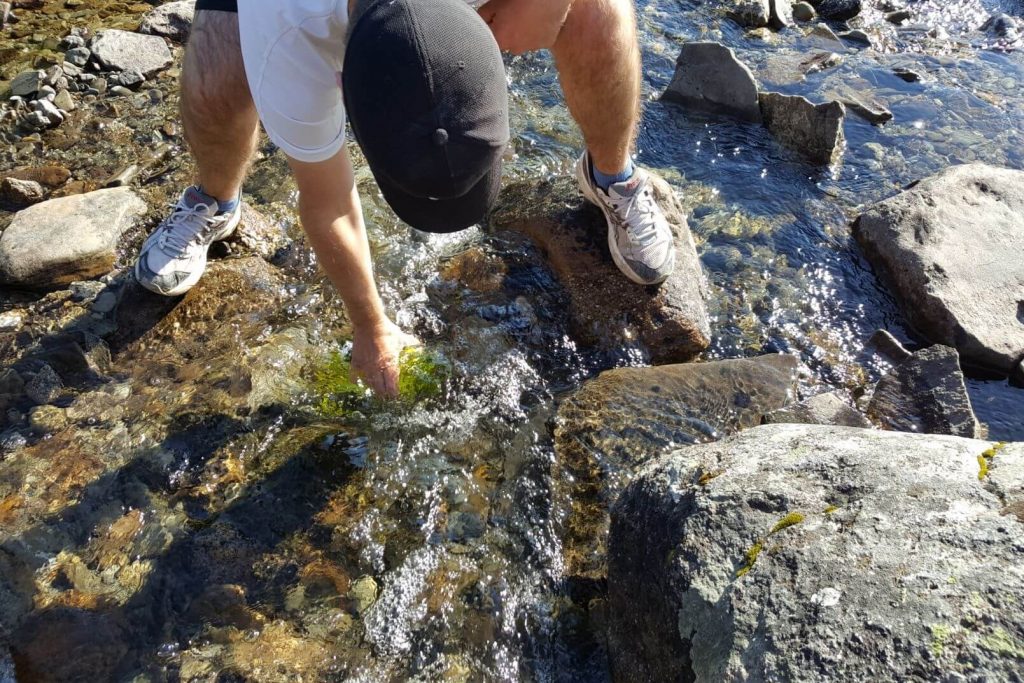
The following is not comprehensive advice on treating water when backcountry camping. Instead, the following is mentioned because it’s super important and I want you to know to do your research if you’ll be out in the wilderness and getting water from natural water sources.
Always look for a fast-flowing water source rather than stagnant water. However, just because it’s fast flowing doesn’t mean it’s 100% safe, so boiling or purifying that water is a must! If not, you could be setting yourself up for some intestinal discomfort or even serious illness!
I prefer to get my water from further out from the bank as well: reaching far out, walking onto a bridge, or taking water from the middle of a river while in the canoe.
Once you have your water, you could use a clean cheese cloth to strain the dirt and weird floaties out before boiling. We like to let our water settle and any “chunks” will usually sink and odd floaters can be poured off from the top.
Next, start heating your water. When your water has reached boiling, let it roll for at least one minute. I prefer to boil for several minutes. More boiling can’t hurt, right? If you’re above 6,500 feet (2000 meters), boil for a minimum of three minutes, since the boiling point will be at a lower temperature at higher elevations (due to lower atmospheric pressure) and you want to make sure your water has gotten hot enough.
VERY IMPORTANT: READ MORE HERE: Here’s a link to the CDC’s guide on how to treat water for safe drinking.
Using a combination of disinfecting or filtering the water as well as boiling is often recommended to make sure you’re eliminating all possible water contaminations.
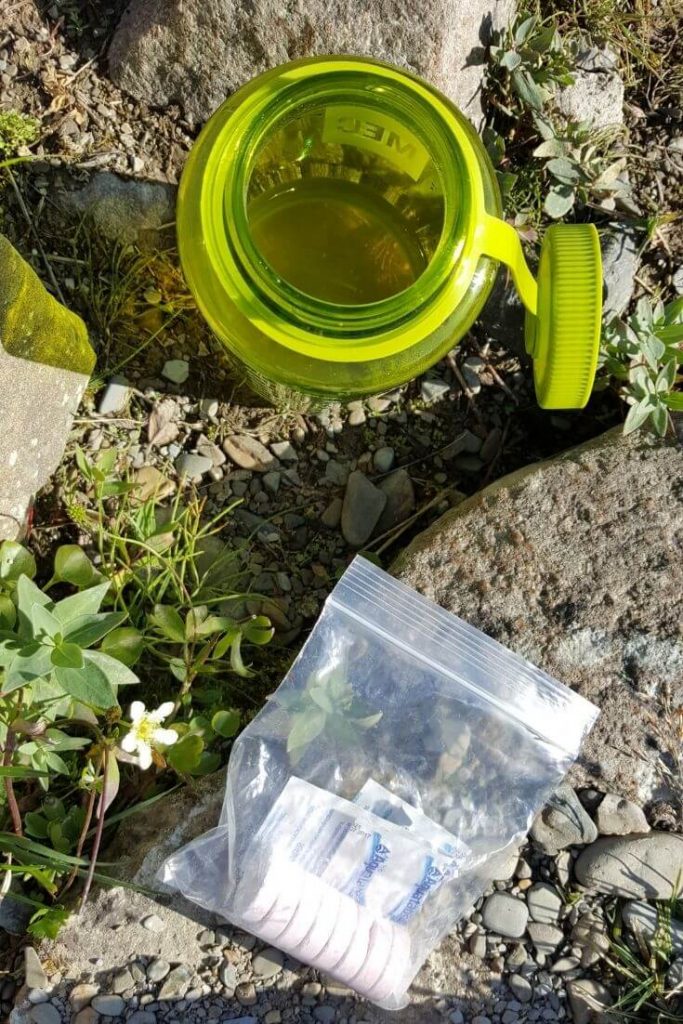
Whether using a camp stove, a fire, or a specialized water boiling system, water can be boiled in many different ways when out in the wilderness. It may be more challenging to do without modern conveniences, but with a bit of planning, easy! These tips will help you figure out how to boil water when camping.
For more camping gear tips, check these out next:
References & Resources:
Center for Disease Control and Prevention: A Guide to Drinking Water Treatment and Sanitation for Backcountry and Travel Use

